In the contemporary landscape, electric guitars exhibit an extensive array of shapes and sizes, continuously evolving to encompass diverse aesthetics. Some boast sleek and refined contours, while others exude boldness with sharp, sporadic lines.
Yet, amidst this variety, questions arise: What significance lies within these diverse designs? Does the body shape of an electric guitar wield a substantial influence over its sound and playability, or is it primarily a matter of visual appeal?
The truth encompasses a blend of these factors, with the balance shifting according to the specific guitar in question. Before delving deeper into the nuances of electric guitar body shapes, it’s pivotal to grasp the distinct body types prevalent in electric guitars and their historical origins. For further insights and guidance on choosing the optimal electric guitar, particularly for beginners, continue reading here.
Exploring Electric Guitar Body Varieties
In the realm of electric guitars, three primary body types prevail:
- Hollow body: These guitars feature a hollow chamber within the body, typically crafted from thin wood panels. The hollow construction produces a warm, resonant tone favored in jazz, blues, and other genres requiring a rich, acoustic-like sound.
- Solid body: As the name suggests, solid-body guitars are crafted from a single, solid piece of wood or multiple pieces glued together. This design offers excellent sustain and resistance to feedback, making solid-body guitars ideal for a wide range of musical styles, including rock, metal, and pop.
- Semi-hollow body: Combining elements of both hollow and solid-body designs, semi-hollow guitars feature a hollow chamber but with a solid center block running through the body. This construction balances warmth and sustain, making semi-hollow guitars versatile instruments suitable for various playing styles.
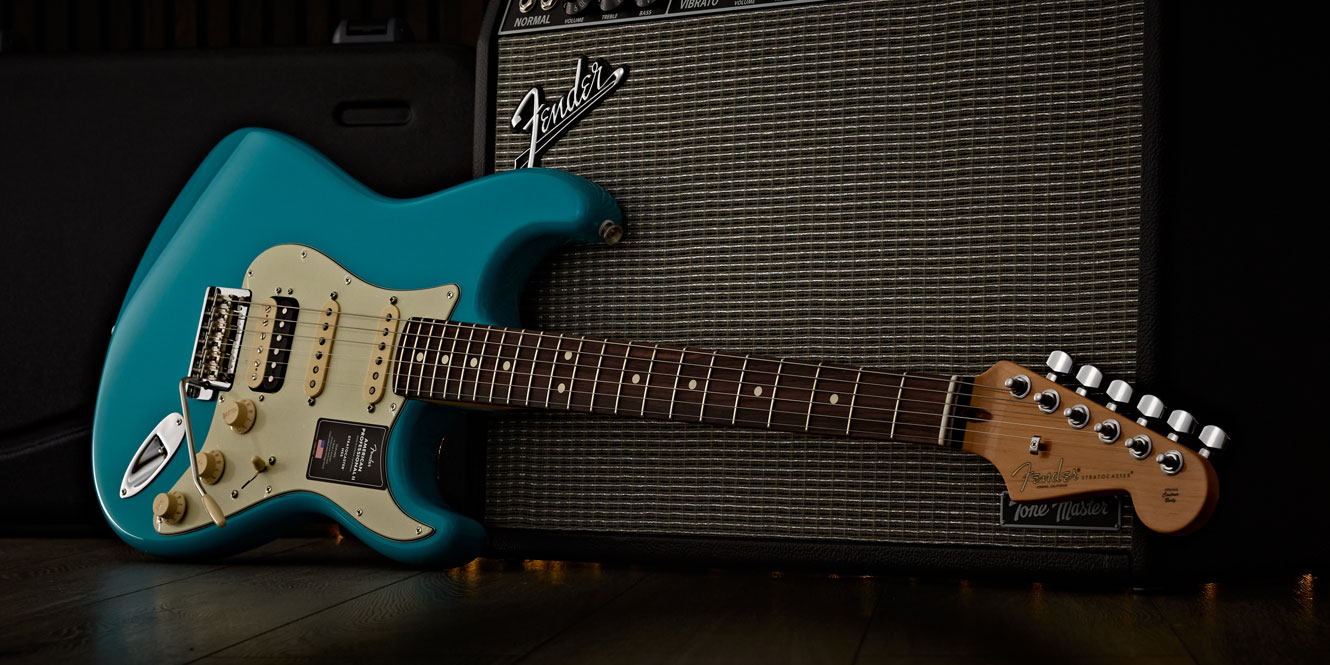
While these three categories serve as the foundation, there are also hybrid designs such as chambered body guitars that blend aspects of both solid and hollow constructions. We’ll explore these distinctions in more detail later on.
Solid Body
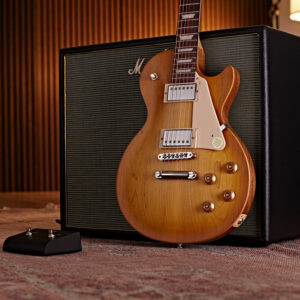
Solid body guitars are indeed the quintessential image that comes to mind when one thinks of electric guitars, and they dominate the market as the most prevalent type.
This design entails the guitar being constructed from one or more solid pieces of wood, devoid of any holes or hollow spaces except where the pickups and controls are situated.
Solid body guitars yield a distinct sound compared to their hollow-bodied counterparts. They offer a wider range of tonal possibilities, contingent upon the specific guitar and, notably, the pickups it employs.
Typically, solid body instruments excel in sustaining notes, owing to the density of the wood, and exhibit superior resistance to feedback. This results in a tighter low-end response and makes them highly compatible with overdriven channels. Consequently, solid body guitars are closely associated with the robust rock sounds for which they were originally conceived.
Hollow Body

Hollow body guitars, as the name suggests, feature hollow interiors. They closely resemble acoustic guitars in their construction, as they were among the earliest electric guitar designs and drew inspiration from acoustic shapes. However, instead of a soundhole, they typically sport two F-holes, along with electric pickups.
Adored by jazz musicians for their rich, warm tones, hollow-bodied electric guitars offer an experience akin to acoustic guitars, even when not plugged in. Their resonance produces a robust, characterful sound that resonates loudly.
While their warm tonality is lauded, hollow body guitars are susceptible to feedback due to their pronounced low end. Consequently, they are often preferred for cleaner guitar tones in jazz and softer rock genres.
An iconic example of a hollow body guitar is the Epiphone Casino, famously used by John Lennon of The Beatles. Its vibrant tones exemplify the charm and sonic richness associated with hollow body instruments.
Semi-Hollow Body
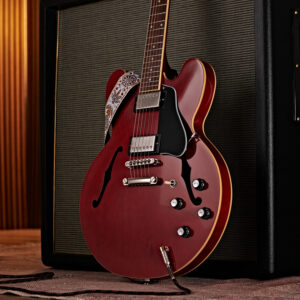
Semi-hollow body guitars were crafted to offer a blend of characteristics from both hollow and solid body guitars, aiming to mitigate the drawbacks associated with each.
While their tone is often likened to that of a hollow body guitar, semi-hollows are more resilient to feedback when subjected to high-gain and overdriven channels. However, pushing them to extreme levels of distortion can still result in feedback issues.
Their sonic palette spans from the softer, rounded tones favored in jazz to the fuzzier, more aggressive humbucking sounds reminiscent of early rock ‘n’ roll.
An exemplary model embodying this balance is the Gibson ES-335, renowned for its versatility and cherished by rock ‘n’ roll icon B.B. King.
Structurally, semi-hollow guitars resemble their hollow-bodied counterparts but incorporate a reinforced solid center running from the neck to beneath the body top, housing the pickups.
Typically sporting a rounded double-cutaway design with two F-holes, semi-hollow guitars boast a classic aesthetic reminiscent of their hollow-bodied and acoustic predecessors. Their large, round, and symmetrical bodies pay homage to the foundational blueprints of semi-hollow design.
Which Option Is Suitable for Me?
Understanding these three categories is paramount as they significantly shape the guitar’s sound.
Choosing the appropriate type hinges on the genre of music you plan to play.
Semi-hollow guitars exhibit versatility, making them suitable for a range of styles such as jazz, pop, blues, and alt-rock, owing to their resonant and acoustic-like tone. Fully hollow guitars are predominantly associated with jazz.
However, in the case of solid body guitars, the primary influence on their sound stems from the pickups. This attribute allows them to adapt to virtually any music genre with increased precision and reduced feedback.
Electric Guitar Body Evolution: A Journey Through History…
In 1931, Electro-string (now Rickenbacker) introduced the groundbreaking ‘Frying Pan’ guitar design, marking the debut of the first-ever electric guitar.
While only a limited number were manufactured, and none were commercially available, this technological innovation proved to be a pivotal moment in music history. It set the stage for the explosive growth of electric guitar production over the past nine decades.
Gibson ES-150 & ES-175
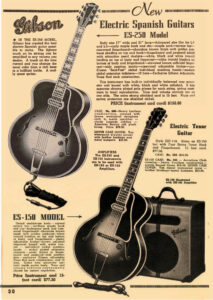
Attribution: This content is licensed under a Creative Commons License by Gibson Guitar Corporation.
Widely recognized as the inaugural commercially successful electric guitar, Gibson unveiled their Spanish-style ES-150 in 1936.
Dubbed after its initial price tag of $150, the “ES” denotes “Electric Spanish,” as its body design drew inspiration from traditional Spanish acoustic guitars.
Equipped with a single pickup, the ES-150 showcased its electric capabilities, swiftly capturing the admiration of jazz guitarists for its gentle and well-rounded tones.
Reflecting the conventional acoustic design, the body shape featured a rounded top and a larger, similarly rounded bottom, categorizing the guitar under the hollow body classification.
Several years later, in 1949, Gibson introduced the ES-175.
This hollow-bodied archtop guitar, akin to the ES-150, boasted a single P90 pickup (later upgraded to two), accompanied by a Florentine cutaway body design that facilitated enhanced access to the upper frets.
While the cutaway design of hollow-bodied guitars may marginally affect their natural resonance and tone, akin to acoustic guitars, this impact was scarcely noticeable on the ES-175. Moreover, the increased access to the higher strings sparked creative exploration among guitar makers, prompting reconsideration of body shapes and designs.
Fender Broadcaster (Telecaster)

In the year preceding Gibson’s release of the ES-175, Fender made a groundbreaking entrance into the guitar market with their inaugural offering – and it was a game-changer. Originally named the Fender Broadcaster but swiftly rebranded as the Fender Telecaster, this guitar marked the advent of the first-ever solid-body design.
Prioritizing functionality and sound over aesthetics, Fender opted for solid blocks of wood to replicate the rich tones of electric Hawaiian guitars while mitigating feedback issues. This innovative approach proved successful, laying the groundwork for further advancements.
The two-pickup solid-body construction featured a bolt-on neck with a truss rod – a pioneering feature in electric guitar design that has since become standard practice for all solid-body builds.
While the Telecaster’s body shape retained elements of the traditional Spanish guitar silhouette, the addition of a cutaway and the incorporation of thin solid wood and slightly squared-off sides gave it a more contemporary and refined look.
Fender’s innovation resulted in a bright, resonant, and responsive sound, remarkably resistant to distorted feedback. It swiftly gained favor among blues and jazz musicians and eventually cemented its status as a staple in country and rock genres in the years to come.
Gibson Les Paul
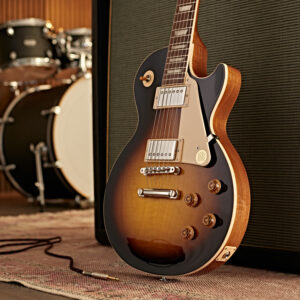
Gibson wasted no time in responding to the Telecaster’s dominance, unleashing their own solid-body contender in 1952: the iconic Les Paul.
Arguably Gibson’s most triumphant creation, the Les Paul emerged from a collaboration between Gibson and jazz virtuoso Les Paul himself.
Featuring a single-cutaway design for improved access to higher frets, the Les Paul followed Fender’s lead by incorporating two pickups. However, it set itself apart with the introduction of the revolutionary humbucking pickups in 1957.
Initially met with mixed reception, the Les Paul faced discontinuation between 1961 and ’68. Yet, its distinctive and commanding sound, courtesy of the humbuckers, propelled it to legendary status in rock music.
Renowned for its unparalleled sustain, the Gibson Les Paul remains an unrivaled icon in the realm of electric guitars, cherished across generations and revered as one of the most illustrious instruments in music history.
Fender Stratocaster
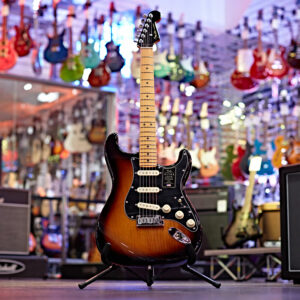
The year 1954 marked a pivotal moment in the history of electric guitars with the introduction of the most iconic and instantly recognizable instrument of all time: the Fender Stratocaster.
In the years following its release, the Fender Stratocaster would emerge as a profoundly influential guitar, representing a significant leap forward in guitar engineering and boasting an array of groundbreaking specifications previously unseen in electric guitars.
Conceived by Fender as the evolutionary successor to the Telecaster, the Stratocaster featured a revolutionary double-cutaway body shape, providing unparalleled access to the higher frets while minimally impacting the guitar’s sound.
Categorized as a solid-body guitar, the Stratocaster introduced rounded edges, a novel design element. More importantly, its configuration of three single-coil pickups with a 5-way selector switch afforded players an unprecedented range of tonal possibilities.
Another groundbreaking feature was the inclusion of the tremolo arm, or “whammy bar,” on all standard models of the Stratocaster. Attached to a floating bridge, the tremolo arm facilitated a new style of playing and expanded sonic expression.
Over the years, this legendary guitar has been wielded by luminaries such as Jimi Hendrix, David Gilmour, Eric Clapton, and countless others, solidifying its status as a game-changing achievement in guitar engineering that will endure for generations to come.
Gibson ES-335
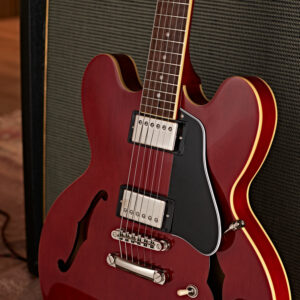
Four years following the debut of the Stratocaster, Gibson returned with their next groundbreaking creation: the Gibson ES-335.
This semi-hollow-bodied guitar, reminiscent of a fusion between the earlier ES-175 and Les Paul models, garnered immediate acclaim upon its release.
Combining the mellower, rounded tones characteristic of hollow-bodied guitars with the bite and aggression of double humbuckers, the ES-335 offered a remarkably versatile playing experience spanning genres from jazz and traditional blues to progressive rock.
Renowned for its diverse sound, the ES-335 also holds a prominent place in pop culture, notably appearing as the instrument played by Marty McFly in the iconic film “Back to the Future,” symbolizing the birth of rock ‘n’ roll.
In addition to its exceptional sound, the ES-335 boasts a striking aesthetic. The blend of classic and modern design elements results in a clean-cut, double-cutaway electro-acoustic appearance that exudes vintage charm.
Fender Jazzmaster
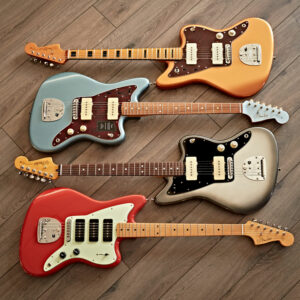
The year 1958 marked a significant milestone in the evolution of the electric guitar landscape. Concurrent with the release of the Gibson ES-335, Fender introduced the Jazzmaster.
Initially targeting jazz guitarists, the Jazzmaster later found its place as a cornerstone in new-wave, alternative, surf, and punk genres.
Fender recognized the flexibility in solid-body guitar shapes, leading to the Jazzmaster’s distinctive design. Characterized by a unique asymmetrical shape, it featured a small, smooth cutaway on the underside and a larger, more angled cutaway on the top side, making it instantly recognizable and visually striking.
The Fender Jazzmaster represented another innovation for Fender, being the first Fender guitar to incorporate two individual tone circuits. Additionally, it was equipped with two single-coil pickups, further expanding its tonal versatility.
Gibson Flying V & Explorer

In 1958, Gibson experienced a banner year with the successful release of the ES-335. Building on this momentum, Gibson introduced two groundbreaking models: the Gibson Flying V and the Gibson Explorer.
These guitars emerged from a company that initially popularized the electric guitar with a body shape closely resembling that of a concert acoustic. However, 22 years later, Gibson boldly departed from tradition with the Flying V and Explorer.
These models represented a departure from convention, showcasing that solid-bodied electric guitar shapes could be pushed to new boundaries while still maintaining a distinctive and consistent tone.
Despite their innovative designs, the Flying V and Explorer did not immediately receive widespread acclaim. Likely ahead of their time, both models were produced in limited quantities and eventually discontinued.
The Flying V was the first to reappear in 1967, followed by the Explorer in 1976, signaling a resurgence of interest in these visionary designs.
Gibson SG
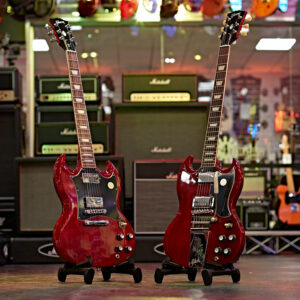
Arguably one of Gibson’s most iconic and instantly recognizable guitars, the Gibson Les Paul SG made its debut in 1961. Originally known as the Gibson Les Paul SG, it was later renamed the Gibson SG after Les Paul expressed disapproval of the design.
Similar in essence to the Gibson Les Paul, the SG boasts a solid body construction and shares certain design elements. However, there are notable differences between the two models.
One distinctive feature of the SG is its sharp double-cutaway design, lending it a more aggressive rock aesthetic compared to the Les Paul. Additionally, the SG sports a slimmer body and neck profile, enhancing maneuverability and facilitating faster playing.
A significant departure from the Les Paul design is the placement of the neck joint, which occurs at the 22nd fret on the SG, rather than the 16th fret on the Les Paul. This configuration allows for easier access to the higher frets, making it ideal for intricate lead playing and shredding – a feature appreciated by guitarists aiming to emulate the high-energy performances of rock legends like Angus Young.
Fender Mustang

Throughout the 1950s, Fender recognized a demand for student guitars, leading to the release of a series of guitars characterized by scaled-down body sizes and slightly shorter scale lengths. In 1964, Fender introduced the final and most successful addition to this student series: the Fender Mustang.
Designed as a solid-body guitar, the Mustang aimed to cater to younger, aspiring guitarists, offering a more comfortable playing experience. Equipped with delicate single-coil pickups, it was tailored for rhythmic and open styles of playing rather than lead.
Despite its smaller size, the Mustang boasted quality sound without significant compromise. Its scaled-down dimensions provided enhanced comfort for players without sacrificing sonic integrity.
The Mustang quickly gained a cult following among alternative, punk, and indie guitarists and remains immensely popular to this day. Notably, it became synonymous with Kurt Cobain, who prominently used it throughout his career with Nirvana.
Discover More
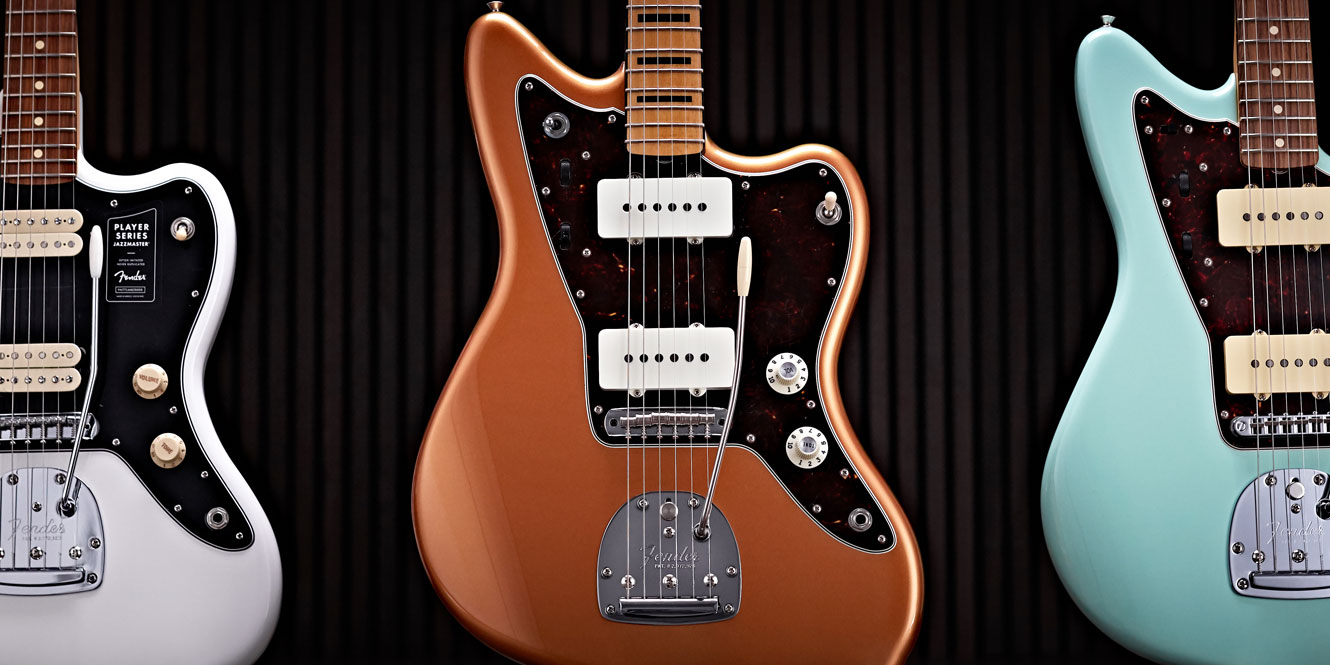
Thus, concludes our crash course on electric guitar body shapes! If you’re into indie rock, explore our article on the history of indie guitars. Or, if you’re a bassist, dive into our guide to electric bass bodies!